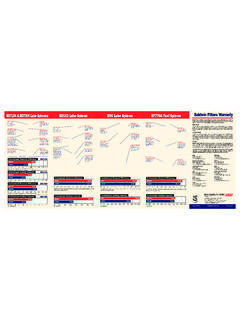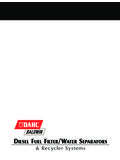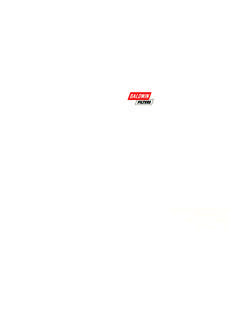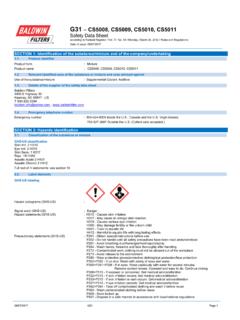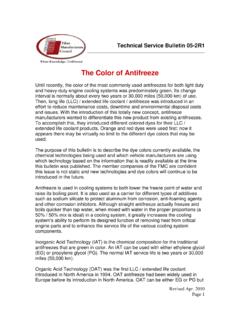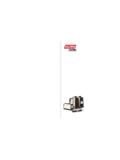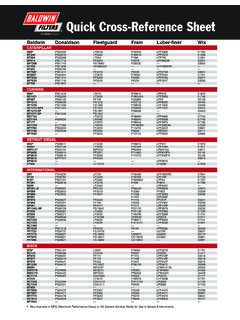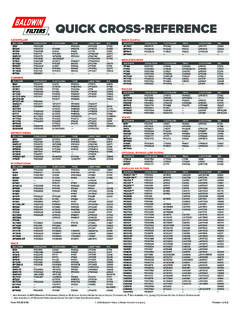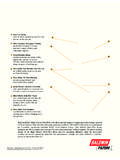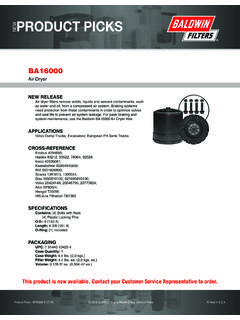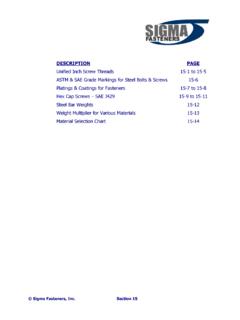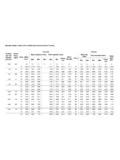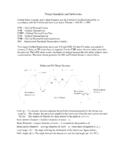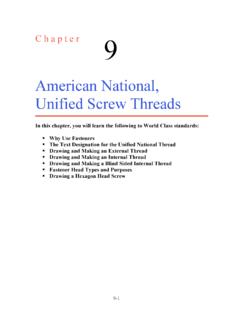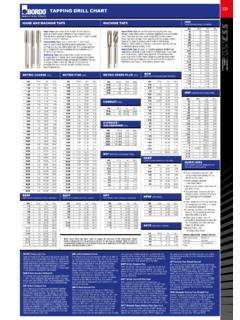Transcription of Spin-On Filter Threads
1 Technical Service Bulletin 94-3R2. Spin-On Filter Threads The Spin-On Filter has become the most popular and widely applied design for liquid filtration products. Among other physical and performance differences, today's Spin-On filters are manufactured with a variety of different thread sizes. Threads in the Filter 's baseplate are designed and manufactured in accordance with the Unified Screw thread System. The Unified Screw thread standards were established in 1948 to provide internationally accepted basic thread standards for an integrated system of Threads for fastening purposes in mechanisms and structures.
2 Spin-On filters are manufactured with specifically sized internal Threads in their baseplate. Filter Threads are produced by one of two manufacturing methods. These methods are commonly called cut or formed (rolled). Both processes produce Threads by inserting a high speed tap into a preformed hole. Rolled Threads and cut Threads gauge identically and are completely interchangeable. The difference between the two Threads is the way they are produced. The forming tap used to produce rolled Threads displaces the metal in the hole while cut Threads utilize a tap that removes metal.
3 Whether cutting or rolling Threads , the hole must be the proper size in order to attain the correct thread height percentage and specified minor diameter. The preformed hole should be sized so the thread percentage is between 60 to 75%. Threads produced with a height above 75% require excessive tapping torque, results in accelerated tap wear, increases the incidents of tap breakage and may also result in engagement interference when installation is attempted. Further, thread strength studies and tests have proven that there is no appreciable increase in thread strength with an increase in thread percentage above 60%.
4 April 2008. Page 1 of 5. While many people's perception is that cut Threads come to a point at their crest, in actuality, the crest of a properly cut and sized thread is flat. In order for a cut thread to have a pointed crest, it would be necessary for the thread to be 100%. height and the cutting tap minor diameter root shaped in a "V" and sharp enough to cut the metal. The height of a thread is determined by the size of the preformed hole. With cut Threads , the preformed hole size will be the minor diameter of the thread . If the hole is the same size as the tap's minor diameter, the thread would be produced at 100% height.
5 As previously mentioned, thread height of 100% is not necessary or desirable. Therefore, the size of the preformed hole must be larger than the tap's minor diameter by enough to produce 60 to 75% height of thread . Forming Threads offers many advantages over cutting Threads . One of these advantages is the fact that rolled Threads are cleaner since the forming tap displaces metal and no metal chips or fragments are produced. Cutting taps produce metal chips that may interfere with the tapping process, cause poor tap lubrication and tap binding or breakage.
6 Additionally, chips produce by a cutting tap must be removed from the baseplate and thread area before the Filter is assembled. Because of the absence of chips, forming taps are far less likely to bind or break and are designed without flutes making them much stronger than a cutting tap. Forming taps do not have a cutting edge that can become dull. These characteristics result in tap life of 3 to 20 times longer and a production speed of to 2 times faster than cutting taps. Because of the difference in the way they are made, rolled Threads require a larger preformed hole size than cut Threads .
7 Unlike cut Threads , the preformed hole size for rolled Threads is not the minor diameter of the finished thread . The preformed hole size is a standard diameter specified by the design size of thread being produced and the percent of thread desired. Rolled Threads are generally stronger than cut Threads due to cold working of the metal in conjunction with the fact that the grain flow of formed Threads follows the April 2008. Page 2 of 5. contour of the thread . Further, primarily because metal is not cut away, rolled thread production greatly decreases the possibilities of producing oversized Threads .
8 One of the most commonly misunderstood characteristics of rolled Threads is the "dip" or "cup" in the crest of the thread . Since forming taps rearrange the metal and the proper height of the thread is between 60 to 75%, the crest of rolled Threads have a concave shape due to the flow of the metal. When observed by one not familiar with thread formation or type, the concave crest of a rolled thread is often interpreted as thread damage and/or a manufacturing error. Forming Tap thread terminology has also been somewhat standardized. Some of the more common terms and definitions are: ALLOWANCE: The intentional or prescribed difference between the thread design size and the thread basic size.
9 ANGLE: The angle included between the flanks of the thread , measured in an axial plane. BASE: The bottom section of a thread . BASIC SIZE: The theoretical control point or base from which size measurements and the limits of allowances and tolerances are calculated. Basic size is based upon a full 100% height thread . CREST: The top surface joining the two flanks of a thread . The crest of an external thread is at its major diameter. The crest of an internal thread is at its minor diameter. DESIGN SIZE: The basic size with allowance applied and from where the limits of size are derived by the application of a tolerance.
10 EXTERNAL thread : A thread rising up from the external surface of cylindrical or conical structure. An example of external thread is the mounting stud on the engine Filter mounting base. FLANK: The surface of the thread which connects the crest with the root. HEIGHT OF thread : The distance between the crest and the base of thread measured normal to the axis. Height of thread is described as a percentage of a full (100%) thread . INTERNAL thread : A thread on a cylindrical or conical internal surface. An example of internal thread would be the Threads in the baseplate of a Spin-On April 2008.
